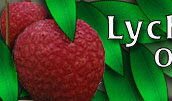The Soil Biology Primer
Chapter 1: THE SOIL FOOD WEB
By Elaine R. Ingham
SOIL BIOLOGY AND THE LANDSCAPE
An incredible diversity of organisms make up the soil food web. They
range in size from the tiniest one-celled bacteria, algae, fungi, and
protozoa, to the more complex nematodes and micro-arthropods, to the
visible earthworms, insects, small vertebrates, and plants.
As these organisms eat, grow, and move through the soil, they make it
possible to have clean water, clean air, healthy plants, and moderated
water flow.
There are many ways that the soil food web is an integral part of
landscape processes. Soil organisms decompose organic compounds, including
manure, plant residue, and pesticides, preventing them from entering water
and becoming pollutants. They sequester nitrogen and other nutrients that
might otherwise enter groundwater, and they fix nitrogen from the
atmosphere, making it available to plants. Many organisms enhance soil
aggregation and porosity, thus increasing infiltration and reducing
runoff. Soil organisms prey on crop pests and are food for above-ground
animals.
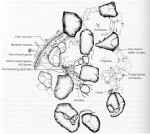 |
The soil environment. Organisms live in
the microscale environments within and between soil particles.
Differences over short distances in pH, moisture, pore size, and the
types of food available create a broad range of
habitats.
Credit: S. Rose and E.T.
Elliott |
THE FOOD WEB: ORGANISMS AND THEIR INTERACTION
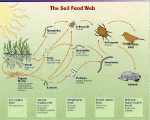 The soil food web is the community of organisms living all or
part of their lives in the soil. A food web diagram shows a series of
conversions (represented by arrows) of energy and nutrients as one
organism eats another (see food web diagram). The soil food web is the community of organisms living all or
part of their lives in the soil. A food web diagram shows a series of
conversions (represented by arrows) of energy and nutrients as one
organism eats another (see food web diagram).
All food webs are fueled by the primary producers: the plants,
lichens, moss, photosynthetic bacteria, and algae that use the sun’s
energy to fix carbon dioxide from the atmosphere. Most other soil
organisms get energy and carbon by consuming the organic compounds found
in plants, other organisms, and waste by-products. A few bacteria, called
chemoautotrophs, get energy from nitrogen, sulfur, or iron compounds
rather than carbon compounds or the sun.
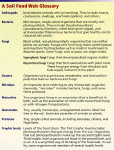 As organisms decompose complex materials, or consume other
organisms, nutrients are converted from one form to another, and are made
available to plants and to other soil organisms. All plants – grass,
trees, shrubs, agricultural crops – depend on the food web for their
nutrition. As organisms decompose complex materials, or consume other
organisms, nutrients are converted from one form to another, and are made
available to plants and to other soil organisms. All plants – grass,
trees, shrubs, agricultural crops – depend on the food web for their
nutrition.
WHAT DO SOIL ORGANISMS DO?
 Growing and reproducing are the primary activities of all
living organisms. As individual plants and soil organisms work to survive,
they depend on interactions with each other. By-products from growing
roots and plant residue feed soil organisms. In turn, soil organisms
support plant health as they decompose organic matter, cycle nutrients,
enhance soil structure, and control the populations of soil organisms
including crop pests. (See table of functions of soil organisms.) Growing and reproducing are the primary activities of all
living organisms. As individual plants and soil organisms work to survive,
they depend on interactions with each other. By-products from growing
roots and plant residue feed soil organisms. In turn, soil organisms
support plant health as they decompose organic matter, cycle nutrients,
enhance soil structure, and control the populations of soil organisms
including crop pests. (See table of functions of soil organisms.)
ORGANIC MATTER FUELS THE FOOD WEB
Soil organic matter is the storehouse for the energy and nutrients used
by plants and other organisms. Bacteria, fungi, and other soil dwellers
transform and release nutrients from organic matter (see photo).
|
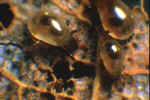
|
These microshredders, immature oribatid mites, skeletonize plant
leaves. This starts the nutrient cycling of carbon, nitrogen, and
other elements.
Collohmannia sp.
Credit: Roy A. Norton, College of Environmental
Science & Forestry, State University of New
York |
Organic matter is many different kinds of compounds – some more useful
to organisms than others. In general, soil organic matter is made of
roughly equal parts humus and active organic matter. Active organic matter
is the portion available to soil organisms. Bacteria tend to use simpler
organic compounds, such as root exudates or fresh plant residue. Fungi
tend to use more complex compounds, such as fibrous plant residues, wood
and soil humus.
Intensive tillage triggers spurts of activity among bacteria and other
organisms that consume organic matter (convert it to CO2), depleting the
active fraction first. Practices that build soil organic matter (reduced
tillage and regular additions of organic material) will raise the
proportion of active organic matter long before increases in total organic
matter can be measured. As soil organic matter levels rise, soil organisms
play a role in its conversion to humus—a relatively stable form of carbon
sequestered in soils for decades or even centuries.
FOOD SOURCES FOR SOIL ORGANISMS
“Soil organic matter” includes all the organic substances in or on the
soil. Here are terms used to describe different types of organic
matter.
Living organisms: Bacteria, fungi, nematodes,
protozoa, earthworms, arthropods, and living roots.
Dead plant material; organic material; detritus; surface
residue: All these terms refer to plant, animal, or other
organic substances that have recently been added to the soil and have only
begun to show signs of decay. Detritivores are organisms that feed on such
material.
Active fraction organic matter: Organic
compounds that can be used as food by microorganisms. The active fraction
changes more quickly than total organic matter in response to management
changes.
Labile organic matter: Organic matter that is
easily decomposed.
Root exudates: Soluble sugars, amino acids and
other compounds secreted by roots.
Particulate organic matter (POM) or Light fraction (LF) organic
matter: POM and LF have precise size and weight
definitions. They are thought to represent the active fraction of organic
matter which is more difficult to define. Because POM or LF is larger and
lighter than other types of soil organic matter, they can be separated
from soil by size (using a sieve) or by weight (using a centrifuge).
Lignin: A hard-to-degrade compound that is part
of the fibers of older plants. Fungi can use the carbon ring structures in
lignin as food.
Recalcitrant organic matter: Organic matter such
as humus or lignin-containing material that few soil organisms can
decompose.
Humus or humified organic matter: Complex
organic compounds that remain after many organisms have used and
transformed the original material. Humus is not readily decomposed because
it is either physically protected inside of aggregates or chemically too
complex to be used by most organisms. Humus is important in binding tiny
soil aggregates, and improves water and nutrient holding capacity.
|
Components of Soil Organic
Matter |
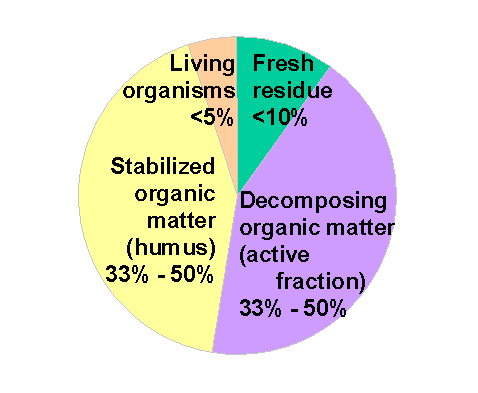 |
WHERE DO SOIL ORGANISMS LIVE?
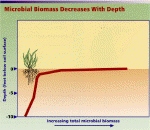 The organisms of the food web are not uniformly distributed
through the soil. Each species and group exists where they can find
appropriate space, nutrients, and moisture. They occur wherever organic
matter occurs – mostly in the top few inches of soil (see figure),
although microbes have been found as deep as 10 miles (16 km) in oil
wells. The organisms of the food web are not uniformly distributed
through the soil. Each species and group exists where they can find
appropriate space, nutrients, and moisture. They occur wherever organic
matter occurs – mostly in the top few inches of soil (see figure),
although microbes have been found as deep as 10 miles (16 km) in oil
wells.
Soil organisms are concentrated:
Around roots. The rhizosphere is the narrow region of
soil directly around roots (see photo). It is teeming with bacteria that
feed on sloughed-off plant cells and the proteins and sugars released by
roots. The protozoa and nematodes that graze on bacteria are also
concentrated near roots. Thus, much of the nutrient cycling and disease
suppression needed by plants occurs immediately adjacent to roots.
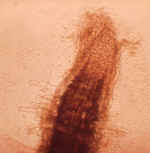 |
Bacteria are abundant around this root tip (the rhizosphere)
where they decompose the plentiful simple organic
substances.
Credit: No. 53 from Soil
Microbiology and Biochemistry Slide Set. 1976 J.P. Martin, et
al., eds. SSSA, Madison WI. |
In litter. Fungi are common decomposers of plant
litter because litter has large amounts of complex, hard-to-decompose
carbon. Fungal hyphae (fine filaments) can “pipe” nitrogen from the
underlying soil to the litter layer. Bacteria cannot transport nitrogen
over distances, giving fungi an advantage in litter decomposition,
particularly when litter is not mixed into the soil profile. However,
bacteria are abundant in the green litter of younger plants which is
higher in nitrogen and simpler carbon compounds than the litter of older
plants. Bacteria and fungi are able to access a larger surface area of
plant residue after shredder organisms such as earthworms, leaf-eating
insects, millipedes, and other arthropods break up the litter into smaller
chunks.
On humus. Fungi are common here. Much organic matter
in the soil has already been decomposed many times by bacteria and fungi,
and/or passed through the guts of earthworms or arthropods. The resulting
humic compounds are complex and have little available nitrogen. Only fungi
make some of the enzymes needed to degrade the complex compounds in
humus.
On the surface of soil aggregates. Biological
activity, in particular that of aerobic bacteria and fungi, is greater
near the surfaces of soil aggregates than within aggregates. Within large
aggregates, processes that do not require oxygen, such as denitrification,
can occur. Many aggregates are actually the fecal pellets of earthworms
and other invertebrates.
In spaces between soil aggregates. Those arthropods
and nematodes that cannot burrow through soil move in the pores between
soil aggregates. Organisms that are sensitive to desiccation, such as
protozoa and many nematodes, live in water-filled pores. (See Figure page
1.)
WHEN ARE THEY ACTIVE?
 The activity of soil organisms follows seasonal patterns, as
well as daily patterns. In temperate systems, the greatest activity occurs
in late spring when temperature and moisture conditions are optimal for
growth (see graph). However, certain species are most active in the
winter, others during dry periods, and still others in flooded
conditions. The activity of soil organisms follows seasonal patterns, as
well as daily patterns. In temperate systems, the greatest activity occurs
in late spring when temperature and moisture conditions are optimal for
growth (see graph). However, certain species are most active in the
winter, others during dry periods, and still others in flooded
conditions.
Not all organisms are active at a particular time. Even during periods
of high activity, only a fraction of the organisms are busily eating,
respiring, and altering their environment. The remaining portion are
barely active or even dormant.
Many different organisms are active at different times, and interact
with one another, with plants, and with the soil. The combined result is a
number of beneficial functions including nutrient cycling, moderated water
flow, and pest control.
THE IMPORTANCE OF THE SOIL FOOD WEB
The living component of soil, the food web, is complex and has
different compositions in different ecosystems. Management of croplands,
rangelands, forestlands, and gardens benefits from and affects the food
web. The next unit of the Soil Biology Primer, “The Food Web & Soil
Health,” introduces the relationship of soil biology to agricultural
productivity, biodiversity, carbon sequestration and to air and water
quality. The remaining six units of the Soil Biology Primer describe the
major groups of soil organisms: bacteria, fungi, protozoa, nematodes,
arthropods, and earthworms. For more information about the diversity
within each organism group, see the list of readings at the end of “The
Food Web & Soil Health” unit.
>Go
to the next chapter: "The Food Web & Soil Health"
<Return
to the Soil Biology Primer home page
Back To Lychee Info
|
